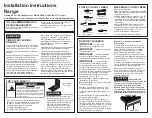
The new US revised electrical code states that all new
construction must use a FOUR WIRE range power cord.
Existing construction in the USA may use a three wire
range power cord. Note: The difference is a four wire
cord has a separate (green) ground, a three wire cord is
grounded through the (white) neutral.
When ordering, if a 3 wire cord is specified, you must
purchase that cord at a Home Depot or hardware store.
To install a 3 wire cord, remove the lower back panel of
the ranges so the power block is visible.
Unscrew the terminal nuts and insert the range cord wires
through the bushing hole and attach the wires to the terminal
block. Tighten the 3 nuts. The center wire of the range cord
must go to the center position ont he terminal block. That
center wire must be grounded to the chassis if it has not been
done so at the factory.
• Attach the ringed terminal of the green or bare copper wire
to the range body with the green ground screw.
• Check power with multimeter. You must have 110 volts
between white and black. You must have 110 volts between
white and red. You must have 220 volts between red and black.
If range receptacle is wired wrong, clock transformer will be
severely damaged and will not be covered by manufacturer’s
warranty. Replace back panel of range. Plug the power cord
in and turn power on.
SAFETY INSTRUCTIONS – GAS
Important Instructions
Do not use range as a heater. Never
use the range as a
kitchen heater. Prolonged use of the range without adequate
ventilation can be hazardous. Oven controls and top burners
are not designed for home heating and component failures
that may result from such abuse are definitely not covered by
the warranty.
WARNING: In the State of Massachusetts, the following
installation instructions apply:
• Installations and repairs must be performed by a qualified
or licensed contractor, plumber, or gasfitter qualified by the
State of Massachusetts.
• If using a ball valve, it shall be a Thandle type.
• A flexible gas connector, when used, must not exceed 3 feet
and or be connected in series.
#1 This installation must conform with local codes and
ordinances. In the absense of local codes, installations must
conform with American National Standard, National Fuel
Gas Code ANSI Z223.1–latest edition (**) or CAN/CGA-
B149–latest edition (***) installation codes.
#2 Input ratings shown on the serial/rating plate are for
elevations up to 2,000 feet (609.6 m). For elevations
above 2,000 feet (609.6 m), ratings are reduced at a rate
of 4% for each 1,000 feet (304.8 cm) above sea level.
Mobile Home Installation
The installation of this range must conform to the
Manufactured Home Construction and Safety Standards,
Title 24 CFR. Part 3280 (formerly the Federal Standard
for Mobile Home Construction and Safety, Title 24, HUD,
Part 280); or when such standard is not applicable, the
Standard for Manufactured Homes Installations 1982
(Manufactured Home Sites, Communities and Setups),
ANSI A225.1q/NFPA 501A* or with local codes.
The installation of this range must conform with the
current standards CAN/CSA-Z240–latest edition*** or
with local codes. When this range is installed in a mobile
home, it must be secured to the floor during transit. Any
method of securing the range is adequate as long as it
conforms to the standards listed above.
Note: The metal chassis of the range MUST be earth-
grounded in order for the control panel and burner spark
ignition to work. Check with a qualified electrician if you
are in doubt as to whether the metal chassis of range is
earth-grounded.
Copies of the standards listed may be obtained from:
* National Fire Protection Association
Batterymarch Park
Quincy, Massachusetts 02269
** American Gas Association
1515 Wilson Boulevard
Arlington, Virginia 22209
*** Canadian Standard Association
178 Rexdale Boulevard
Rexdale (Toronto), Ontario M9W 1R3
Floor Covering
Never install a range over inferior kitchen carpeting, vinyl
tile or linoleum. These should be able to withstand at least
175°F without shrinking, warping or discoloring.
Curtains
If your range is near a window, use an appropriate
window treatment. Do not use long curtains which could
blow over the top burners and create a fire hazard.
If You Smell Gas
If this is a new range installation, your installer has not
done a proper job of checking for leaks. Connections can
loosen in transportation. If the range connections are not
perfectly tight, you can have a small leak and therefore a
faint gas smell.
FINDING A GAS LEAK IS USUALLY NOT A
“DO IT YOURSELF” PROCEDURE.
Some leaks can only be found with the controls in the
“on” position exposing the user to serious burns. Never
use a match or flame to locate a leak.
Turn off the gas to
the range and call a qualified serviceman.
Flame Size:
Top burner flame size should be adjusted so
it does not extend beyond the edge of the cooking utensil.
Excessive flame is hazardous.
Use of High Flame:
When using a high flame, never
leave any pans unattended on this heat setting for long
periods. Hot oil is particularly hazardous since it can
become hot enough to ignite.
6







































